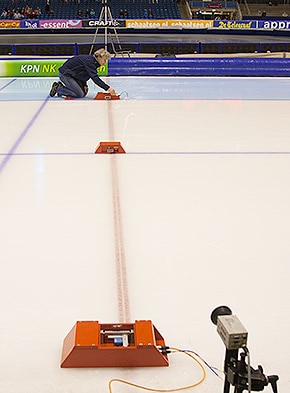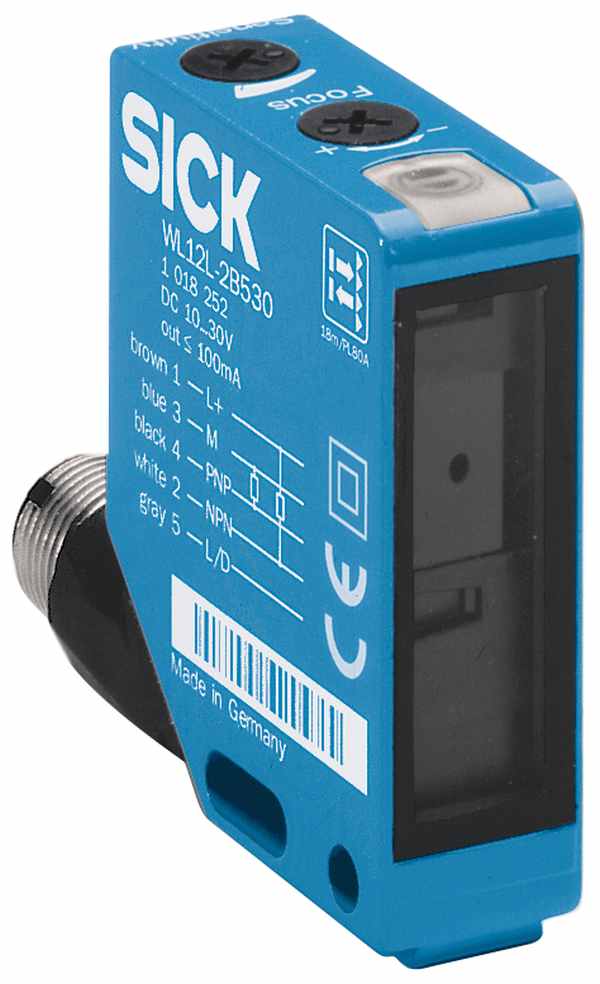Nobody loves their speed skating as much as the Dutch. Winter is a succession of one competition rapidly following another. Needless to say, it is extremely important not only to the competitors, but also to the enthusiastic ranks of spectators, that the finish times can be displayed immediately. The Dutch speed skating association (KNSB) has been using timekeeping technology from SICK since the 1990s.
 KNSB, Stadium in Thialf
KNSB, Stadium in Thialf
"Having the times available instantly is simply a must for every speed skating competition," say Jeroen Fredriks and Erik van den Boogert, two system developers who have been appointed by the Dutch speed skating association (KNSB) to record the times. "Why has the KNSB developed its own timing system? This is partly due to the financial importance of speed skating," explains Jeroen Fredriks. "Competing on two skates is enormously popular in the Netherlands and a handful of other countries, yet from a global view it remains something of a niche sport. Commercial interests are therefore largely focused on the timing systems, as the market for these is considerably larger. There are a few systems that have been developed specifically for the demands of our sport, yet they struggle to meet all our needs. Often these systems are kitted out with high-quality measuring equipment and detectors, but as soon as they develop a mechanical fault they become useless for our purposes. What's more they tend to be quite difficult to move around; we would prefer something more portable."
One Track, One System
Erik van den Boogert continues: "As we are responsible for timekeeping at the KNSB, we are constantly on the lookout for the most advanced technology for our timing systems. Our technicians are always on hand at the most important competitions, leaving us with enough time to set up every critical component right down to the finest detail. At the end of the day these measuring units have to be simple to assemble on the ice before the start of the competition. With our KNSB timing team, we have developed proper solutions and systems even for these applications, and largely by ourselves too."
 KNSB, Stadium in Thialf
KNSB, Stadium in Thialf
"The majority of speed skating tracks in the Netherlands tend to have two or three systems at any one time. At least two systems have to be available in order to provide a backup if one fails. Since the 1990s, these systems have been fitted with sensors from SICK. In previous years these were always LED sensors, but in future we plan to use SICK WL12L laser sensors. These offer even greater accuracy and are more user-friendly, allowing us to save time when setting up the systems."

Timed by Transponder Systems
Before electronic timekeeping came along, referees relied completely on their stopwatches. Even modern coaches still use their trusty stopwatches, albeit with one eye also on the results flashing up in real time on the display boards. Fredriks: "At important competitions the times are recorded by three parallel systems: the transponder system, the photo-finish, and the optical finish line detectors fitted with sensors from SICK."

For the transponder system, twelve measuring loops are flush-mounted into the ice tracks of the Thialf arena. Two of these are on the finish lines of the 500 meter and 1000 meter stretches. Every skater wears a transponder with a unique ID number around each of their ankles. As soon as a participant passes over a measuring loop, the system is able to identify who has just passed by. The average speed between this and the immediately preceding loop is calculated and then shown simultaneously on both the display board and in the TV station's production control room. Additional data, such as the total number of laps completed and differences in the average speed to earlier laps, is also provided. Thanks to this system the skaters can be depicted as a set of moving points on the referees' screens and a whole set of important data can be obtained. The photo-finish is made up of two separate systems. The first is coupled to the transponder system, the second functions completely independently and also has its own start control.
Optical Solution for Displaying in Real Time
 WL12L
WL12L
Van den Boogert: "The laser detectors with sensors from SICK are unbelievably precise. They can record finish times to three decimal places. Such a system is important to be able to generate a "time event" in real time when the finish line is crossed. On the whole the system works excellently, but we would like to be able to guarantee 100% reliability - this means that for timing we ultimately need a multisystem that falls back on different technologies." "As we are constantly comparing the measurements from all three systems against each other, we can also filter out causes for measuring errors that are not immediately obvious. For example, a skater's foot could be just above the laser beam when they cross the finish line, or the tip of the skate could be at a slight angle. Invariably the transponder and photo-finish times have to match. If any discrepancies occur, we have to be able to find a reason. Plus we always have two other systems to serve as a comparison if one should fail." Fredriks: "The data flow is not just sent to the stadium's displays, TV stations and individual handheld devices. We are also experimenting with the Apps we have developed for iPhone, iPad and Android. As a result the data output from the SICK sensors is indispensable for all those looking to follow the unrestricted action on their current mobile devices."
Laser competence from SICK
- Product informationen: Small photoelectric sensors WL12L
- Product portfolio: Small photoelectric sensors
- Website: KNSB

